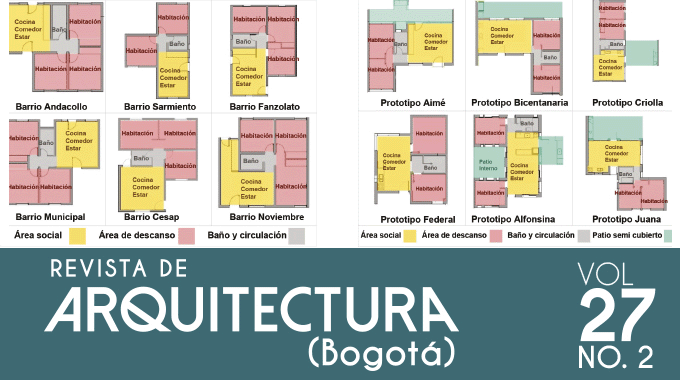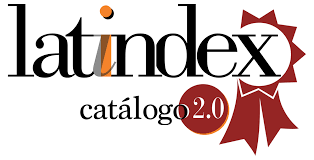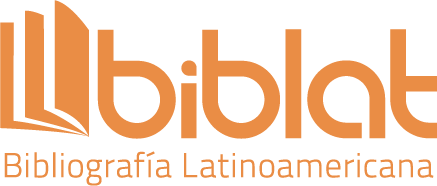

This work is licensed under a Creative Commons Attribution-NonCommercial 4.0 International License.
Revista de Arquitectura is an open access journal. More information...
Authors retain copyright and grant to the Revista de Arquitectura the right of first publication, which will be simultaneously subject to the Creative Commons (CC) BY-NC license.
Authors will sign a non-exclusive distribution license for the published version of the article by completing (RevArq FP03 Permission to Reproduce).
Self-archiving will comply with SHERPA/RoMEO guidelines and the Green classification.
To see in detail these guidelines, please consult...
Abstract
The COVID-19 pandemic and the global lockdown measures transformed household dynamics, solidifying remote work as a growing trend in the post-pandemic era. This change invites reflection: how do our homes adapt to the challenges of remote work? In this context, this research aims to evaluate the level of satisfaction of residents in social housing regarding the integration of remote work activities in warm temperate climates. To this end, six case studies were analyzed, and surveys were conducted on the sensation and perception of comfort in the homes. The results show that these homes do not provide an adequate level of comfort during remote workdays, highlighting issues such as visual discomfort, low adaptability, and spatial discomfort. Based on these findings, critical reflections are proposed on the architectural and spatial characteristics necessary to ensure comfort in social housing in remote work contexts. Among the highlighted issues, it is suggested that future studies explore the impact of minimal ventilation surfaces, the arrangement of homes with non-party walls, and designs that promote contact with the natural environment as key elements to improve habitability. These reflections aim to open new lines of research that contribute to the development of housing policies more aligned with contemporary challenges.
Keywords

References
Acosta, I., Campano, M. Á., Bellia, L., Fragliasso, F., Diglio, F., & Bustamante, P. (2023). Impact of daylighting on visual comfort and on the biological clock for teleworkers in residential buildings. Buildings, 13(10), 2562. https://doi.org/10.3390/buildings13102562
Arrieta, G. M. (2020). Valoraciones subjetivas y condiciones objetivas de confort térmico en viviendas. Arquitecno, (16), 57-66. https://doi.org/10.30972/arq.0164553
Bianchi, A. R., & Cravero, S. A. C. (2010). Atlas climático digital de la República Argentina. Ediciones INTA; Estación Experimental Agropecuaria Salta, 56. https://repositorio.inta.gob.ar/handle/20.500.12123/16040
Cuerdo-Vilches, T., Navas-Martín, M. Á., & Oteiza, I. (2021a). Working from home: is our housing ready?
International Journal of Environmental Research and Public Health, 18(14), 7329. https://doi.org/10.3390/ijerph18147329
Cuerdo-Vilches, T., Navas-Martín, M. Á., March, S., & Oteiza, I. (2021b). Adequacy of telework spaces in homes during the lockdown in Madrid, according to socioeconomic factors and home features. Sustainable Cities and Society, 75, 103262. https://doi.org/10.1016/j.scs.2021.103262
da Silva Mota, J. (2019). Utilização do Google Forms na pesquisa acadêmica. Humanidades y Inovação, 6(12), 371-373. https://revista.unitins.br/index.php/humanidadeseinovacao/article/view/1106
De Salvio, D., D'Orazio, D., & Garai, M. (2021). Unsupervised analysis of background noise sources in active offices. The Journal of the Acoustical Society of America, 149(6), 4049-4060. https://doi.org/10.1121/10.0005129
de Sousa Figueira, A., Reis Costa, S. R., Ferraz, F. T., Rampasso, I. S., & Resende, D. N. (2023). An analysis of teleworking management practices. Work, 74(3), 1135-1148. https://doi.org/10.3233/WOR-211401
Díaz, C. J., & Czajkowski, J. D. (2004). Comportamiento térmico de viviendas populares en Tierra del Fuego (Argentina). Avances en Energías Renovables y Medio Ambiente, 8. http://sedici.unlp.edu.ar/handle/10915/81701
Doi, T. (2023). Investigation of a home office environment and lifestyles of workers that affect their perceived comfort in work-from-home. En T. Ahram & W. Karwowski (Eds.), Emerging technologies and future of work. AHFE (2023) International Conference. AHFE Open Access, vol 117. AHFE International, USA. http://doi.org/10.54941/ahfe1004429
Elizondo, J. (2023). Il lavoro a distanza in Argentina. Convenzione OIL n. 177 e legge 27.555. Diritti individuali e collettivi. Labour & Law Issues, 9(1), C.59-C.77. https://doi.org/10.6092/issn.2421-2695/17534
Felgueiras, F., Mourão, Z., Moreira, A., & Gabriel, M. F. (2023). Indoor environmental quality in offices and risk of health and productivity complaints at work: A literature review. Journal of Hazardous Materials Advances, 10, 100314. https://doi.org/10.1016/j.hazadv.2023.100314.
Felipe Contin de Oliveira, S., Aletta, F., & Kang, J. (2023). Self-rated health implications of noise for open-plan office workers: An overview of the literature. Building Acoustics, 30(2), 105-125. https://doi.org/10.1177/1351010X231152841
Fissore, V. I., Fasano, S., Puglisi, G. E., Shtrepi, L., & Astolfi, A. (2023). Indoor environmental quality and comfort in offices: a review. Buildings, 13(10), 2490. https://doi.org/10.3390/buildings13102490
Genoud, M. A., Broveglio, G., & Ramos, M. de P. (2023). ¿Teletrabajadores o tele explotados? Implicaciones en las vivencias laborales y extralaborales en pandemia en Argentina. Cuadernos Latinoamericanos de Administración, 19(36). https://doi.org/10.18270/cuaderlam.v19i36.3968
Instituto Nacional de Estadísticas y Censos. (2022) Población. INDEC 2022. https://censo.gob.ar/index. php/datos_definitivos_total_pais/
International Labour Organization. Inclusive Labour Markets, L. R. and W. C. B. (2020). Teleworking during the COVID-19 pandemic and beyond: a practical guide (1st ed.). ILO. https://labordoc.ilo.org/ discovery/fulldisplay?context=L&vid=41ILO_INST:41ILO_V2&search_scope=ALL_ILO&tab=ALL_ ILO&docid=alma995088493502676
IRAM. (2012). Norma IRAM 11603. Acondicionamiento térmico de edificios. Clasificación bioambiental de la República Argentina.
Kamińska, J., Radosz, J., & Kapica, Ł. (2023). Visual perception and workload of office workers in various acoustic conditions. bioRxiv, 2023-02. https://doi.org/10.1101/2023.02.15.528721
Karaman, G. D., & Avci, A. N. (2022). Analyzing natural lighting conditions from the perspective of biophilic design in indoor office environments. IOP Conference Series: Earth and Environ- mental Science, 1099(1), 012034. IOP Publishing. https://iopscience.iop.org/article/10.1088/1755- 1315/1099/1/012034
Koga, Y., Kojima, Y., Oki, C., & Kono, A. (2023). Review of various standards for window views in office building. Journal of Environmental Engineering (Transactions of AIJ), 88(806), 255-264. https:// doi.org/10.3130/aije.88.255
Kojima, Y., Ohki, C., Kawano, A., Takagi, N., Koga, Y., Majima, R., Okamoto, T., & Jarrin, F. (2023). Assessing views from office buildings in virtual reality. Journal of Physics: Conference Series, 2600(11), Article 112014. https://doi.org/10.1088/1742-6596/2600/11/112014
Letourneux, F., & Schütz, G. (2022). Remote work: From employee telework to self-employed homebased work? En Shifting categories of work (pp. 46-58). Routledge. https://www.taylorfrancis.com/chapters/edit/10.4324/9781003341321-5/remote-work-fr%C3%A9d%C3%A9rique-letourneux-gabrielle-sch%C3%BCtz
Meo, A. I., & Dabenigno, V. (2021). Teletrabajo docente durante el confinamiento por COVID19 en Argentina. Condiciones materiales y perspectivas sobre la carga de trabajo, la responsabilidad social y la toma de decisiones. Revista de Sociología de la Educación-RASE, 14(1), 103-127. https:// doi.org/10.7203/RASE.14.1.18221
Mercado, M. V., Esteves, A., & Filippín, C. (2010). Thermal-energy efficiency of a social house in the city of Mendoza, Argentina. Ambiente Construido, 10(2), 87-100. https://doi.org/10.1590/S1678-86212010000200006
Michaux, M. C., Viegas, G. M., & Blasco Lucas, I. A. (2021). Evolución y crecimiento oficial en vivi- endas del Instituto Provincial de la Vivienda. Revista de Arquitectura, 26(41), 6-15. https://doi. org/10.5354/0719-5427.2021.65019
Mohammad A Y B., Abdelkader, M., Neseem, A., & Mustafá, A. (2022). Impact of the geometric form of the building envelopes on the efficiency of natural lighting in the office space. IOP Confer- ence Series: Earth and Environmental Science, 992(1), 012001. https://doi.org/10.1088/1755- 1315/992/1/012001
Naranjo, Y. A., & Kuchen, E. (2021). Indicadores para evaluar el rendimiento de usuarios de oficina en clima templado cálido. Informes de la Construcción, 73(564), e420-e420. https://doi.org/10.3989/ic.83476
Nazari, S., MirzaMohammadi, P. K., Sajadi, B., Ha, P. P., Talatahari, S., & Sareh, P. (2023). Designing ener- gy-efficient and visually-thermally comfortable shading systems for office buildings in a cool- ing-dominant climate. Energy Reports, 10, 3863-3881. https://doi.org/10.1016/j.egyr.2023.10.062
Ongkowiyono, J. O., Budianto, G. N. T., Armelia, E. F., Ongkowiyono, V. A., & Mediastika, C. E. (2024). The adaptive thermal comfort of individual performance working at home. ARTEKS: Jurnal Teknik Arsitektur, 9(2), 201-208. ttps://doi.org/10.30822/arteks.v9i2.3261
Park, H. Y., Vigeant, M. C., & Dittberner, A. (2022). Assessing cognitive effects of transportation noise on office workers with electroencephalography and performance. J. Acoust. Soc. Am., 152(4_Supplement), A210. https://doi.org/10.1121/10.0016038
Pasau, R., Al Asy'Ary, M. F., & Sabudu, M. (2024). Optimizing the use of natural lighting. Journal of Architecture and Human Experience, 2(1), 17–22. https://doi.org/10.59810/archimane.v2i1.35
Powell, K. (2010). Making sense of place: Mapping as a multisensory research method. Qualitative Inquiry, 16(7), 539-555. https://doi.org/10.1177/1077800410372600
Ramos Sánz, A. I. (2021). Satisfacción de habitabilidad durante el confinamiento por Covid-19. Estudio comparativo de dos tipologías de vivienda en Argentina. CONTEXTO. Revista de la Facultad de Arquitectura de la Universidad Autónoma de Nuevo León, 15(23), 28-44. https://doi.org/10.29105/contexto15.23-281
Sáez, V., Quintana Gallardo, A., Garzón, B., & Guillén Guillamón, I. E. (2023). The influence of acoustic standards in construction: a case study of social housing in Argentina. Editorial Universitat Politècnica de València. https://doi.org/10.4995/VIBRArch2022.2022.15204
Sturesson, L. (2002). The mis-match between suppliers and users in telework. En Teleworking (pp.56-73). Routledge. https://www.taylorfrancis.com/chapters/edit/10.4324/9780203053089-29/mis-match-suppliers-users-telework-lennart-sturesson
Thayanithy, D., & Perera, N. (2023). Daylight and window view quality for visual comfort: the case of an office building in Jaffna. Built-environment Sri Lanka, 13(2), 5-22. https://doi.org/10.4038/besl.v13i2.7680
Unidad de Innovación y Desarrollo Educativo (UNIDE). (2020). https://geoportal.sanjuan.gob.ar/geoportal/#7/-30.916/-68.621
Uribe Olaya, L. & Evan López, J. (2021). Aplicación de la ley 1221 de 2008 en tiempos de Sars-Covid 19. Universidad Cooperativa de Colombia. https://hdl.handle.net/20.500.12494/33428
Wegertseder-Martínez, P. (2023). The need for a paradigm shift toward an occupant-centered environmental control model. Sustainability, 15(7), 5980. https://doi.org/10.3390/su15075980
Wu, Z., & Kim, C. (2020). Research on the application of natural daylighting system in office space. En The 2nd International Conference on Architecture: Heritage, Traditions and Innovations (AHTI 2020) (pp. 329-333). Atlantis Press. https://doi.org/10.2991/assehr.k.200923.056
Yang, W., Lin, Y., & Fatourehchi, D. (2024). Thermal comfort. En Routledge handbook of high-performance workplaces. Routledge. https://doi.org/10.1201/9781003328728-7
































